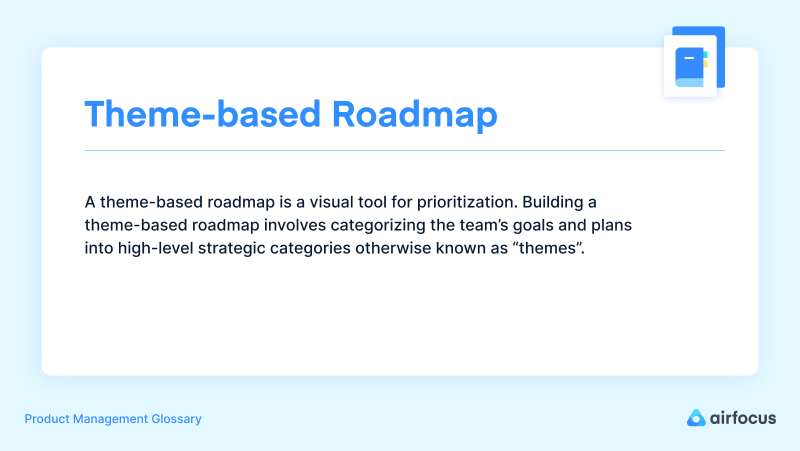Theme-based Roadmap
What is a theme-based roadmap?
Theme-based Roadmap
A theme-based roadmap is a visual tool for prioritization. Building a theme-based roadmap involves categorizing the team’s goals and plans into high-level strategic categories otherwise known as “themes”.
The top-down approach of a theme-based roadmap helps teams to prioritize some of the major themes on the roadmap. The roadmap will include examples of epics relating to each theme to help guide decision-making.
Benefits of a theme-based roadmap
A theme-based roadmap will visualize high-level goals and plans in relation to the product strategy. It’s a way of establishing complete clarity to the question “Why are we building the product in this way?”.
With so many other roadmaps available, you may wonder why a theme-based roadmap is a good choice. Technology roadmaps already give us an outline of technical requirements, and date- or time-based roadmaps offer timeframes to complete the work, so how does putting themes on a roadmap help?
Think about a political campaign for a moment. Candidates aren’t out on the podium making dry speeches about specific pieces of legislation. They’re trying to instill strong emotions in their audience with catch-all phrases, which helps to secure buy-in more effectively than focusing on the minutia. Theme-based roadmaps take this notion and translate it into a product development context.
To a development team, a product can just be a compilation of various features. Yet that’s not what a customer sees — and nor is it what helps your product to sell. Theming helps give teams a better idea of how the customer views your product as you’re building it.
Theme-based roadmaps also help to connect plans to strategy. Themes help stakeholders link features to business-level objectives, which is really their only concern. This can help you secure buy-in from the stakeholders without the usual back and forth.
Theme-based roadmaps also help stakeholders understand why certain features aren’t feasible by aligning all parties around goals in the context of available resources. This can improve team cohesion by putting a stop to feature suggestions that may be a little too ambitious.
When should you use a theme-based roadmap?
Theme-based roadmaps are most helpful in the early stages of development when the team is still focused on delivering core features. This is because the roadmap will help to guide prioritization efforts. The theme-based roadmap may show that an idea that’s already being developed isn’t worth pursuing, resulting in wasted time, money, and resources.
As a prioritization tool, theme-based roadmaps are great for developing time-bound products. If you’re working towards strict deadlines, you can use the theme-based roadmap to quickly identify which features should be prioritized to deliver the most value possible within a limited timeframe.
As with most things in life, theme-based roadmaps aren’t suited for every occasion. They work best with projects where requirements are rarely changed. As any agile team will tell you, this is a situation that product teams rarely find themselves in. Other visualization tools may be better if you’re working in a fast-paced environment with regular requirement changes.
How to create a theme-based roadmap
Creating a theme-based roadmap is a little more complex than some other roadmapping processes. To keep it simple, let’s break the process down into three steps.
Step 1 - Collect pain-points
As any great product manager will tell you, each feature you build into a product should look to address real customer needs — otherwise, there’s little reason for them to buy or use it.
Before we can start to group features into themes, we need to identify the customer pain points we need to address. This will involve a decent amount of market research, including data analysis, surveys, user interviews, and so on. Once you know what issues you’re trying to solve, you can start brainstorming ideas.
Step 2 - Grouping and analysis
Once you have your list of features/ideas/requests, you can start grouping them into themes. Each group is then analyzed by the team to find the answers to the following questions:
Does this group represent the biggest customer pain point we need to solve?
What will happen if we focus on this particular group?
What value does this group offer toward our business objectives?
Does this group mesh with the company’s vision?
Does this group require immediate attention, or can it be delayed?
The answers to these questions will help dictate the development process and prioritize themes.
Step 3 - Discussion and collaboration
Step 2 will leave you with a rough game plan for the development process. However, we need to be certain we’re about to head off on the right track before we dive in.
Step 3 tasks us with having in-depth conversations surrounding the plan. These conversations should include someone from the development team, stakeholders, and potential users. If they find issues with your development strategy, you should seek their ideas to help shape the game plan with their feedback. Continue step 3 until a consensus is reached between all parties.
Tips to make the best out of your theme-based roadmap
Theme-based roadmaps may seem confusing at first, but by following these tips you can get the best out of them.
Define outcomes
Gather plenty of data
Validate assumptions before building the roadmap
Avoid HiPPO
Identify initiatives
Make sure each goal is measurable
Embrace collaboration
Update your theme-based roadmap on a regular basis

General FAQ

Glossary categories
Build great roadmaps

Experience the new way of doing product management








